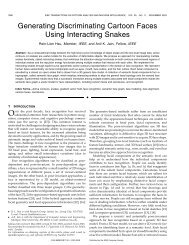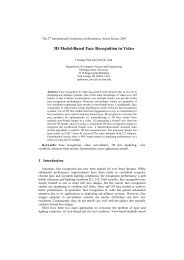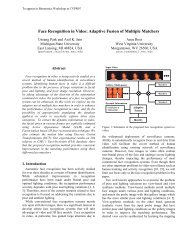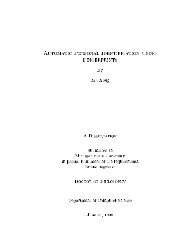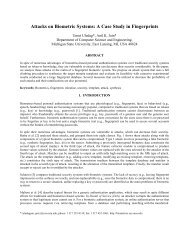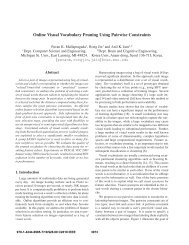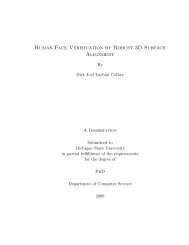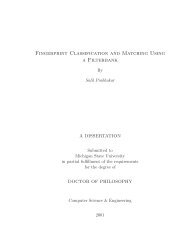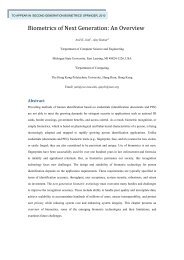Face Detection and Modeling for Recognition - Biometrics Research ...
Face Detection and Modeling for Recognition - Biometrics Research ...
Face Detection and Modeling for Recognition - Biometrics Research ...
You also want an ePaper? Increase the reach of your titles
YUMPU automatically turns print PDFs into web optimized ePapers that Google loves.
normalized red-green (r-g) space [156] is not the best choice <strong>for</strong> face detection [157],<br />
[158]. Based on Terrillon et al.’s [157] comparison of nine different color spaces <strong>for</strong><br />
face detection, the tint-saturation-luma (TSL) space provides the best results <strong>for</strong><br />
two kinds of Gaussian density models (unimodal <strong>and</strong> mixture of Gaussian densities).<br />
We adopt the Y C b C r space since it is perceptually uni<strong>for</strong>m [155], is widely used in<br />
video compression st<strong>and</strong>ards (e.g., MPEG <strong>and</strong> JPEG) [21], <strong>and</strong> it is similar to the<br />
TSL space in terms of the separation of luminance <strong>and</strong> chrominance as well as the<br />
compactness of the skin cluster. Many research studies assume that the chrominance<br />
components of the skin-tone color are independent of the luminance component [159],<br />
[160], [158], [90]. However, in practice, the skin-tone color is nonlinearly dependent<br />
on luminance. In order to demonstrate the luma dependency of skin-tone color, we<br />
manually collected training samples of skin patches (853, 571 pixels) from 9 subjects<br />
(137 images) in the Heinrich-Hertz-Institute (HHI) image database [15]. These pixels<br />
<strong>for</strong>m an elongated cluster that shrinks at high <strong>and</strong> low luma in the Y C b C r space,<br />
shown in Fig. 3.3(a). Detecting skin tone based on the cluster of training samples in<br />
the C b -C r subspace, shown in Fig. 3.3(b), results in many false positives. If we base<br />
the detection on the cluster in the (C b /Y )-(C r /Y ) subspace, shown in Fig. 3.3(c), then<br />
many false negatives result. The dependency of skin tone color on luma is also present<br />
in the normalized rgY space in Fig. 3.4(a), the perceptually uni<strong>for</strong>m CIE xyY space<br />
in Fig. 3.4(c), <strong>and</strong> the HSV spaces in Fig. 3.4(e). The 3D cluster shape changes at<br />
different luma values, although it looks compact in the 2D projection subspaces, in<br />
Figs. 3.4(b), 3.4(d) <strong>and</strong> 3.4(f).<br />
To deal with the skin-tone color dependence on luminance, we nonlinearly trans-<br />
63



